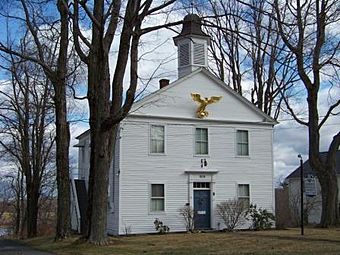Goshen Historic District (Goshen, Connecticut) facts for kids
Quick facts for kids |
|
|
Goshen Historic District
|
|

Goshen Academy building, in 2010
|
|
| Location | CT 63 and 4, and Gifford Rd., Goshen, Connecticut |
|---|---|
| Area | 160 acres (65 ha) |
| Built | 1760 |
| Architectural style | Greek Revival, Federal, Victorian |
| NRHP reference No. | 82000996 |
| Added to NRHP | December 27, 1982 |
The Goshen Historic District is a special area in the town of Goshen, Connecticut. It's like a time capsule that shows what a small American village looked like long ago. This historic district includes the main part of Goshen, where two important roads, Connecticut Routes 4 and 63, meet.
This area was once a busy crossroads for old "turnpikes," which were early toll roads. Even today, it still feels like a quiet, old-fashioned country village. Many of the buildings here are homes from the early 1800s. You can also find old churches, a general store, and the town's former town hall from 1895. In 1982, this district was added to the National Register of Historic Places, which means it's recognized as an important historical site.
Contents
Exploring Goshen's Historic Center
The Goshen Historic District is a fascinating place to learn about American history. It shows how a small town grew and changed over many years. The buildings tell stories of the people who lived and worked here centuries ago.
How Goshen Village Grew
The town of Goshen is located in the beautiful hills of northwestern Connecticut. It was first settled in the mid-1700s. The village center grew because of two important roads. One road went east-west between Torrington and Sharon (now Route 4). The other went north-south between Litchfield and Canaan (now Route 63).
Goshen has always been a rural town, mostly focused on farming. It didn't have much industry. However, in the mid-1800s, a blacksmith named Simon Scoville helped the village economy. He started a factory that made carriages. While his factory is no longer there, you can still find parts of an old iron furnace that belonged to him. Simon Scoville also built many simple homes for his workers. These homes were built in the popular "Greek Revival" style.
What You'll See in the District
The Goshen Historic District mainly stretches along Route 63. It starts at Lyman Lane in the south and goes up to the modern town hall complex in the north. It also extends east along Route 4.
The historic buildings in this area show different styles of architecture. You can see examples of Greek Revival, Federal, and Victorian buildings. Some of these buildings date back as far as 1760!
The most important buildings in the district are the public and religious ones. These include the Goshen Academy and the Goshen Congregational Church, which was built in 1832. The Old Town Hall, built in 1895, is right at the main crossroads. It's a special example of "Shingle style" architecture. You can also find other Victorian-era homes, like the Lavallette-Perrin House, which mixes Greek and Gothic styles.
Images for kids







